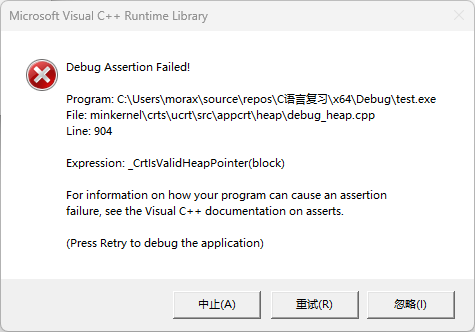指针
内存含义:
- 存储器:计算机的组成中,用来存储程序和数据,辅助CPU进行运算处理的重要部分。
- 内存:内部存贮器,暂存程序/数据——掉电丢失 SRAM、DRAM、DDR、DDR2、DDR3。
- 外存:外部存储器,长时间保存程序/数据—掉电不丢ROM、ERRROM、FLASH (NAND、NOR)、硬盘、光盘。
内存是沟通CPU与硬盘的桥梁:
- 暂存放CPU中的运算数据
- 暂存与硬盘等外部存储器交换的数据
物理存储器和存储地址空间
有关内存的两个概念:物理存储器和存储地址空间。
物理存储器:实际存在的具体存储器芯⽚。
- 主板上装插的内存条
- 显⽰卡上的显⽰RAM芯⽚
- 各种适配卡上的RAM芯⽚和ROM芯⽚
存储地址空间:对存储器编码的范围。我们在软件上常说的内存是指这一层含义。
- 编码:对每个物理存储单元(一个字节)分配一个号码
- 寻址:可以根据分配的号码找到相应的存储单元,完成数据的读写
内存地址
将内存抽象成一个很⼤的一维字符数组。编码就是对内存的每一个字节分配一个32位或64位的编号(与32位或者64位处理器相关)。这个内存编号我们称之为内存地址。
内存中的每一个数据都会分配相应的地址:
char:占一个字节分配一个地址int: 占四个字节分配四个地址float、struct、函数、数组等
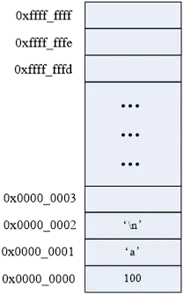
指针和指针变量
- 如果在程序中定义了一个变量,在对程序进行编译或运行时,系统就会给这个变量分配内存单元,并确定它的内存地址(编号)
- 指针的实质就是内存“地址”。指针就是地址,地址就是指针。
- 通常我们叙述时会把指针变量简称为指针,实际他们含义并不一样。
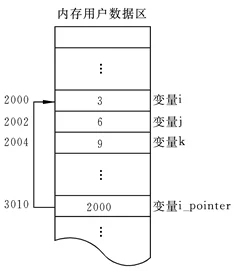
指针是一种数据类型,占用内存空间,用来保存内存地址。
#include <stdio.h>
#include <stdlib.h>
#include <string.h>
void test() {
int *p1 = 0x1234;
int ***p2 = 0x1111;
printf("p1 size:%d\n", sizeof(p1));
printf("p2 size:%d\n", sizeof(p2));//指针是变量,指针本⾝也占内存空间,指针也可以被赋值
int a = 10;
p1 = &a;
printf("p1 address:%p\n", &p1);
printf("p1 address:%p\n", p1);
printf("a address:%p\n", &a);
}
int main(void) {
test();
return 0;
}程序输出:
p1 size:8
p2 size:8
p1 address:0x7fffffffe3d8
p1 address:0x7fffffffe3cc
a address:0x7fffffffe3cc指针变量的定义和使用
- 指针变量指向谁,就把谁的地址赋值给指针变量
*操作符操作的是指针变量指向的内存空间
#include <stdio.h>
int main(){
int a = 0;
char b = 100;
printf("a=%d, &a=%p\n", a, &a);
printf("b=%c, &b=%p\n", b, &b);
int *p;
// int *代表一种数据类型,int *指针类型,p才是变量名
// 定义了一个指针类型的变量,可以指向一个int类型变量的地址
p = &a;
// 将a的地址赋值给变量p。p也是一个变量,值是一个内存地址编号
putchar('\n');
printf("p=%x, &p=%p, *p=%d\n", p, &p, *p);
// p指向了a的地址,*p就是a的值
char *p1 = &b;
printf("p1=%x, &p1=%p, *p1=%c\n", p1, &p1, *p1);
// p1指向了b的地址,*p1就是b的值
return 0;
}程序输出:
a=0, &a=0x16d7575b8
b=d, &b=0x16d7575b7
p=6d7575b8, &p=0x16d7575a8, *p=0
p1=6d7575b7, &p1=0x16d7575a0, *p1=d⚠️ 注意
&可以取得一个变量在内存中的地址。但是,,因为寄存器变量不在 内存里,而在CPU里⾯,所以是没有地址的。
间接访问操作符
通过一个指针访问它所指向的地址的过程叫做间接访问,或者叫解引用指针,这个用于执行间接访问的操作符是*。
注意:对一个int*类型指针解引用会产生一个整型值,类似地,对一个float*指针解引用会产生了一个float类型的值。
- 在指针声明时,
*号表⽰所声明的变量为指针 - 在指针使用时,
*号表⽰操作指针所指向的内存空间**相当通过地址(指针变量的值)找到指针指向的内存,再操作内存*放在等号的左边赋值(给内存赋值,写内存)*放在等号的右边取值(从内存中取值,读内存)
#include <stdio.h>
#include <stdlib.h>
//解引用
void test01() {//定义指针
int *p = NULL;
//指针指向谁,就把谁的地址赋给指针
int a = 10;
p = &a;
*p = 20;//*在左边当左值,必须确保内存可写
//*号放右⾯,从内存中读值
int b = *p;//必须确保内存可写
char *str = "hello world!";
*str = 'm';
printf("a:%d\n", a);
printf("*p:%d\n", *p);
printf("b:%d\n", b);
}
int main(void) {
test01();
return 0;
}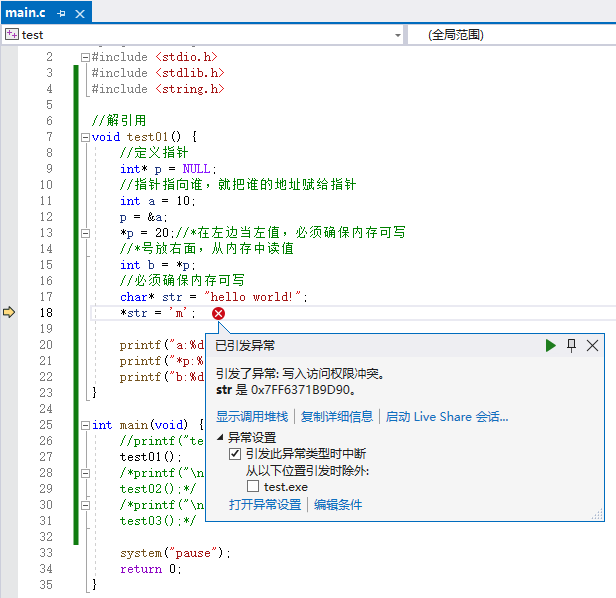
通过指针间接修改变量的值
#include <stdio.h>
int main(){
int a = 0;
int b = 11;
int *p = &a;
printf("修改前:\na=%d, b=%d\n", a, b);
*p = 100;
puts("\n修改后");
printf("a=%d, *p=%d\n", a, *p);
p = &b;
*p = 22;
printf("b=%d, *p=%d\n", b, *p);
return 0;
}程序输出:
修改前:
a=0, b=11
修改后
a=100, *p=100
b=22, *p=22指针大小
- sizeof()测的是指针变量指向存储地址的⼤⼩
- 在32位平台,所有的指针(地址)都是32位(4字节)
- 在64位平台,所有的指针(地址)都是64位(8字节)
#include <stdio.h>
#include <stdlib.h>
int main(void) {
int *p1;
int **p2;
char *p3;
char **p4;
printf("sizeof(p1) = %d\n", sizeof(p1));
printf("sizeof(p2) = %d\n", sizeof(p2));
printf("sizeof(p3) = %d\n", sizeof(p3));
printf("sizeof(p4) = %d\n", sizeof(p4));
printf("sizeof(double *) = %d\n", sizeof(double *));
return 0;
}程序输出:
sizeof(p1) = 8
sizeof(p2) = 8
sizeof(p3) = 8
sizeof(p4) = 8
sizeof(double *) = 8野指针和空指针
指针变量也是变量,是变量就可以任意赋值,不要越界即可(32位为4字节,64位为8字节),但是,,此指针指向的区域是未知(操作系统不允许操作此指针指向的内存区域)。
int a = 100;
int *p;
p = a; //把a的值赋值给指针变量p,p为野指针, ok,不会有问题,但没有意义
p = 0x12345678; //给指针变量p赋值,p为野指针, ok,不会有问题,但没有意义
*p = 1000; //操作野指针指向未知区域,内存出问题,err但是,野指针和有效指针变量保存的都是数值,为了标志此指针变量没有指向任何变量(空闲可用),C语⾔中,可以把NULL赋值给此指针,这样就标志此指针为空指针,没有任何指针。
int *p = NULL;NULL是一个值为0的宏常量: #define NULL ((void *)0)
TIP
野指针指向一个已删除的对象或未申请访问受限内存区域的指针。与空指针不同,野指针⽆法通过简单地判断是否为 NULL避免,而只能通过养成良好的编程习惯来尽力减少。
什么情况下会导致野指针?
指针变量未初始化
任何指针变量刚被创建时不会⾃动成为NULL指针,它的缺省值是随机的,它会乱指一⽓。所以,指针变量在创建的同时应当被初始化,要么将指针设置为NULL,要么让它指向合法的内存。
指针释放后未置空
有时指针在free或delete后未赋值 NULL,便会使人以为是合法的。别看free和delete的名字(尤其是delete),它们只是把指针所指的内存给释放掉,但并没有把指针本⾝⼲掉。此时指针指向的就是“垃圾”内存。释放后的指针应⽴即将指针置为NULL,防⽌产生“野指针”。
指针操作超越变量作用域
不要返回指向栈内存的指针或引用,因为栈内存在函数结束时会被释放。
示例
#include <stdio.h>
#include <stdlib.h>
void test() {
int *p = 0x001;//未初始化
printf("%p\n", p);
*p = 100;
}
int main(void) {
test();
return 0;
}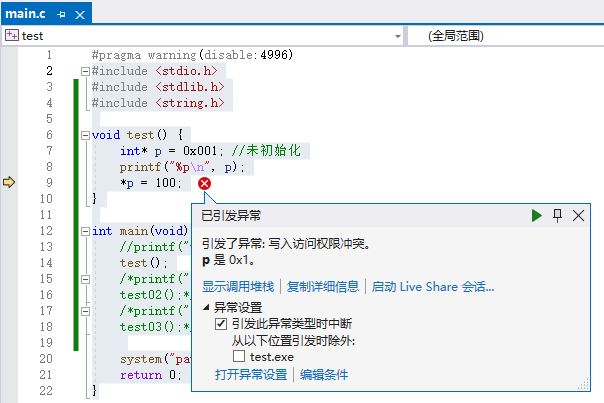
操作野指针是非常危险的操作,应该规避野指针的出现:
初始化时置 NULL
指针变量一定要初始化为NULL,因为任何指针变量刚被创建时不会⾃动成为NULL指针,它的缺省值是随机的。
释放时置 NULL
当指针p指向的内存空间释放时,没有设置指针p的值为NULL。delete和free只是把内存空间释放了,但是并没有将指针p的值赋为NULL。通常判断一个指针是否合法,都是使用if语句测试该指针是否为NULL。
标准定义了NULL指针,它作为一个特殊的指针变量,表⽰不指向任何东西。要使一个指针为NULL,可以给它赋值一个零值。为了测试一个指针百年来那个是否为NULL,你可以将它与零值进行比较。
对指针解引用操作可以获得它所指向的值。但从定义上看,NULL指针并未指向任何东西,因为对一个NULL指针因引用是一个非法的操作,在解引用之前,必须确保它不是一个NULL指针。
如果对一个NULL指针间接访问会发生什么呢?结果因编译器而异。
不允许向NULL和非法地址拷贝内存:
#include <stdio.h>
#include <stdlib.h>
void test() {
char *p = NULL;
//给p指向的内存区域拷贝内容
strcpy(p, "1111");//err
char *q = 0x1122;
//给q指向的内存区域拷贝内容
strcpy(q, "2222");//err
}
int main(void) {
test();
return 0;
}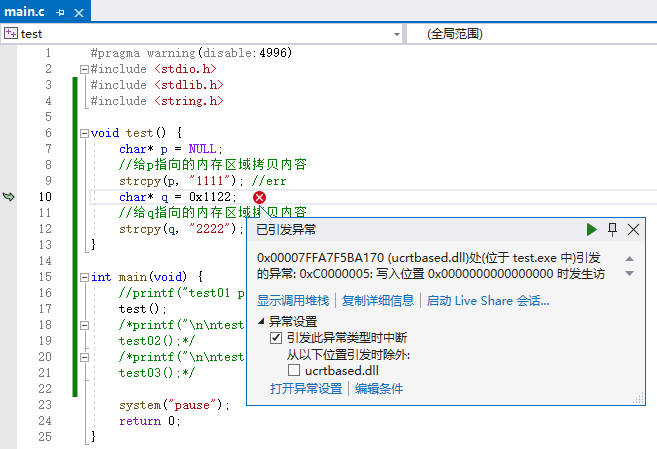
泛型指针(万能指针)void *
void *指针也叫做万能指针、泛型指针。可以指向任意变量的内存空间:
#include <stdio.h>
#include <stdlib.h>
int main(void) {
void *p = NULL;
int a = 10;
p = (void *) &a;//指向变量时,最好转换为void *
//使用指针变量指向的内存时,转换为int *
*((int *) p) = 11;
printf("a = %d\n", a);
return 0;
}程序输出:
a = 11指针的步长
指针是一种数据类型,是指它指向的内存空间的数据类型。指针所指向的内存空间决定了指针的步长。指针的步长指的是,当指针+1时候,移动多少字节单位。
思考如下问题:
#include <stdio.h>
#include <stdlib.h>
int main(void) {
int a = 0xaabbccdd;
unsigned int *p1 = &a;
unsigned char *p2 = &a;
//为什么*p1打印出来正确结果?
printf("%x\n", *p1);
//为什么*p2没有打印出来正确结果?
printf("%x\n", *p2);
//为什么p1指针+1加了4字节?
printf("p1 =%d\n", p1);
printf("p1+1=%d\n", p1 + 1);
//为什么p2指针+1加了1字节?
printf("p2 =%d\n", p2);
printf("p2+1=%d\n", p2 + 1);
return 0;
}程序输出:
aabbccdd
dd
p1 =-7176
p1+1=-7172
p2 =-7176
p2+1=-7175const修饰的指针变量
int a = 100;
int b = 200;
//指向常量的指针
//修饰*,指针指向内存区域不能修改,指针指向可以变
const int * p1 = &a; //等价于int const *p1 = &a;
//*p1 = 111; //err
p1 = &b; //ok
//指针常量
//修饰p1,指针指向不能变,指针指向的内存可以修改
int * const p2 = &a;
//p2 = &b; //err
*p2 = 222; //ok#include <stdio.h>
#include <stdlib.h>
//const修饰变量
void test01() {
//1. const基本概念
const int i = 0;//i = 100; //错误,只读变量初始化之后不能修改
//2. 定义const变量最好初始化
const int j;
//j = 100; //错误,不能再次赋值
//3. c语⾔的const是一个只读变量,并不是一个常量,可通过指针间接修改
const int k = 10;//k = 100; //错误,不可直接修改,我们可通过指针间接修改
printf("k:%d\n", k);
int *p = &k;
*p = 100;
printf("k:%d\n", k);
}
//const 修饰指针
void test02() {
int a = 10;
int b = 20;
//const放在*号左侧 修饰p_a指针指向的内存空间不能修改,但可修改指针的指向
const int *p_a = &a;
//*p_a = 100; //不可修改指针指向的内存空间
p_a = &b;//可修改指针的指向
//const放在*号的右侧, 修饰指针的指向不能修改,但是可修改指针指向的内存空间
int *const p_b = &a;
//p_b = &b; //不可修改指针的指向
*p_b = 100;//可修改指针指向的内存空间
//指针的指向和指针指向的内存空间都不能修改
const int *const p_c = &a;
}
//const指针用法
struct Person {
char name[64];
int id;
int age;
int score;
};
//每次都对对象进行拷贝,效率低,应该用指针
void printPersonByValue(struct Person person) {
printf("Name:%s\n", person.name);
printf("Name:%d\n", person.id);
printf("Name:%d\n", person.age);
printf("Name:%d\n", person.score);
}
//但是用指针会有副作用,可能会不⼩⼼修改原数据
void printPersonByPointer(const struct Person *person) {
printf("Name:%s\n", person->name);
printf("Name:%d\n", person->id);
printf("Name:%d\n", person->age);
printf("Name:%d\n", person->score);
}
void test03() {
struct Person p = {"Obama", 1101, 23, 87};
//printPersonByValue(p);
printPersonByPointer(&p);
}
int main(void) {
printf("test01 print:\n");
test01();
printf("\n\ntest02 print:\n");
test02();
printf("\n\ntest03 print:\n");
test03();
return 0;
}程序输出:
test01 print:
buf:aaaa
test02 print:
buf:123456a
test03 print:
buf:abcdefg
test01 print:
k:10
k:10
test02 print:
test03 print:
Name:Obama
Name:1101
Name:23
Name:87多级指针
C语⾔允许有多级指针存在,在实际的程序中一级指针最常用,其次是二级指针。二级指针就是指向一个一级指针变量地址的指针。三级指针基本用不着,但考试会考。
int a = 10;
int *p = &a; //一级指针
*p = 100; //*p就是a
int **q = &p; //*q就是p //**q就是a
int ***t = &q; //*t就是q //**t就是p //***t就是a指针的意义——间接赋值
间接赋值的三大条件
通过指针间接赋值成⽴的三⼤条件:
- 2个变量(一个普通变量一个指针变量、或者一个实参一个形参)
- 建⽴关系
- 通过 * 操作指针指向的内存
void test() {
int a = 100; //两个变量
int* p = NULL;
//建⽴关系
//指针指向谁,就把谁的地址赋值给指针
p = &a;
//通过*操作内存
*p = 22;
}如何定义合适的指针变量
void test() {
int b;
int* q = &b; //0级指针
int** t = &q;
int*** m = &t;
}间接赋值:从0级指针到1级指针
#include <stdio.h>
#include <stdlib.h>
int func1() { return 10; }
void func2(int a) {
a = 100;
}
//指针的意义_间接赋值
void test02() {
int a = 0;
a = func1();
printf("a = %d\n", a);
//为什么没有修改?
func2(a);
printf("a = %d\n", a);
}
//指针的间接赋值
void func3(int *a) {
*a = 100;
}
void test03() {
int a = 0;
a = func1();
printf("a = %d\n", a);
//修改
func3(&a);
printf("a = %d\n", a);
}
int main(void) {
printf("test02 print:\n");
test02();
printf("\n\ntest03 print:\n");
test03();
return 0;
}程序输出:
test02 print:
a = 10
a = 10
test03 print:
a = 10
a = 100间接赋值:从1级指针到2级指针
#include <stdio.h>
#include <stdlib.h>
#include <string.h>
void AllocateSpace(char **p) {
*p = (char *) malloc(100);
strcpy(*p, "hello world!");
}
void FreeSpace(char **p) {
if (p == NULL) { return; }
if (*p != NULL) {
free(*p);
*p = NULL;
}
}
void test() {
char *p = NULL;
AllocateSpace(&p);
printf("%s\n", p);
FreeSpace(&p);
if (p == NULL) { printf("p内存释放!\n"); }
}
int main(void) {
test();
return 0;
}程序输出:
hello world!
p内存释放!间接赋值的推论
- 用1级指针形参,去间接修改了0级指针(实参)的值。
- 用2级指针形参,去间接修改了1级指针(实参)的值。
- 用3级指针形参,去间接修改了2级指针(实参)的值。
- 用n级指针形参,去间接修改了n-1级指针(实参)的值。
指针和数组
数组名
数组名字是数组的⾸元素地址,但它是一个地址常量:
#include <stdio.h>
#include <stdlib.h>
int main(void) {
int a[] = {1, 2, 3, 4, 5, 6, 7, 8, 9};
printf("a = %p\n", a);
printf("&a[0] = %p\n", &a[0]);
//a = 10; //err, 数组名只是常量,不能修改
return 0;
}程序输出:
a = 0x7fffffffe3d0
&a[0] = 0x7fffffffe3d0指针操作数组元素
#include <stdio.h>
#include <stdlib.h>
int main(void) {
int a[] = {1, 2, 3, 4, 5, 6, 7, 8, 9};
int i = 0;
int n = sizeof(a) / sizeof(a[0]);
for (i = 0; i < n; i++) {
//printf("%d, ", a[i]);
printf("%d, ", *(a + i));
}
printf("\n");
int *p = a;//定义一个指针变量保存a的地址
for (i = 0; i < n; i++) {
p[i] = 2 * i;
}
for (i = 0; i < n; i++) {
printf("%d, ", *(p + i));
}
printf("\n");
return 0;
}程序输出:
1, 2, 3, 4, 5, 6, 7, 8, 9,
0, 2, 4, 6, 8, 10, 12, 14, 16,指针加减运算
加法运算
- 如果是一个
int *,+1的结果是增加一个int的⼤⼩ - 如果是一个
char *,+1的结果是增加一个char⼤⼩
#include <stdio.h>
#include <stdlib.h>
int main(void) {
int a;
int *p = &a;
printf("%d\n", p);
p += 2;//移动了2个int
printf("%d\n", p);
char b = 0;
char *p1 = &b;
printf("%d\n", p1);
p1 += 2;
printf("%d\n", p1);
return 0;
}程序输出:
-7176
-7168
-7185
-7183通过改变指针指向操作数组元素:
#include <stdio.h>
#include <stdlib.h>
int main(void) {
int a[] = {1, 2, 3, 4, 5, 6, 7, 8, 9};
int i = 0;
int n = sizeof(a) / sizeof(a[0]);
int *p = a;
for (i = 0; i < n; i++) {
printf("%d, ", *p);
p++;
}
printf("\n");
return 0;
}程序输出:
1, 2, 3, 4, 5, 6, 7, 8, 9,减法运算
示例1
#include <stdio.h>
#include <stdlib.h>
int main(void) {
int a[] = {1, 2, 3, 4, 5, 6, 7, 8, 9};
int i = 0;
int n = sizeof(a) / sizeof(a[0]);
int *p = a + n - 1;
for (i = 0; i < n; i++) {
printf("%d, ", *p);
p--;
}
printf("\n");
return 0;
}程序输出:
9, 8, 7, 6, 5, 4, 3, 2, 1,示例2
#include <stdio.h>
#include <stdlib.h>
int main(void) {
int a[] = {1, 2, 3, 4, 5, 6, 7, 8, 9};
int *p2 = &a[2];//第3个元素地址
int *p1 = &a[1];//第2个元素地址
printf("p1 = %p\np2 = %p\n", p1, p2);
int n1 = p2 - p1;//n1 = 1
int n2 = (int) p2 - (int) p1;//n2 = 4
printf("n1 = %d, n2 = %d\n", n1, n2);
return 0;
}程序输出:
p1 = 0x7fffffffe3d4
p2 = 0x7fffffffe3d8
n1 = 1, n2 = 4指针数组
指针数组,它是数组,数组的每个元素都是指针类型。
#include <stdio.h>
#include <stdlib.h>
int main(void) {
//指针数组
int *p[3];
int a = 1;
int b = 2;
int c = 3;
int i = 0;
p[0] = &a;
p[1] = &b;
p[2] = &c;
for (i = 0; i < sizeof(p) / sizeof(p[0]); i++) {
printf("%d, ", *(p[i]));
}
printf("\n");
return 0;
}程序输出:
1, 2, 3,指针和字符串
字符指针
#include <stdio.h>
#include <stdlib.h>
int main(void) {
char str[] = "hello world";
char *p = str;
*p = 'm';
p++;
*p = 'i';
printf("%s\n", str);
p = "mike jiang";
printf("%s\n", p);
char *q = "test";
printf("%s\n", q);
return 0;
}程序输出:
millo world
mike jiang
test字符指针做函数参数
#include <stdio.h>
#include <stdlib.h>
void mystrcat(char *dest, const char *src) {
int len1 = 0;
int len2 = 0;
while (dest[len1]) { len1++; }
while (src[len2]) { len2++; }
int i;
for (i = 0; i < len2; i++) {
dest[len1 + i] = src[i];
}
}
int main(void) {
char dst[100] = "hello mike";
char src[] = "123456";
mystrcat(dst, src);
printf("dst = %s\n", dst);
return 0;
}程序输出:
dst = hello mike123456指针数组做为main函数的形参
int main(int argc, char *argv[]);- main函数是操作系统调用的,第一个参数标明argc数组的成员数量,argv数组的每个成员都是char *类型
- argv是命令行参数的字符串数组
- argc代表命令行参数的数量,程序名字本⾝算一个参数
#include <stdio.h>
#include <stdlib.h>
//argc: 传参数的个数(包含可执行程序)
//argv:指针数组,指向输⼊的参数
int main(int argc, char *argv[]) {
//指针数组,它是数组,每个元素都是指针
char *a[] = {"aaaaaaa", "bbbbbbbbbb", "ccccccc"};
int i = 0;
printf("argc = %d\n", argc);
for (i = 0; i < argc; i++) {
printf("%s\n", argv[i]);
}
return 0;
}程序输出:
argc = 1
/home/morax/code/Build_files/format.outconst修饰的指针变量
#include <stdio.h>
#include <stdlib.h>
#include <string.h>
int main(void) {
//const修饰一个变量为只读
const int a = 10;
//a = 100; //err
//指针变量, 指针指向的内存, 2个不同概念
char buf[] = "aklgjdlsgjlkds";
//从左往右看,跳过类型,看修饰哪个字符
//如果是*, 说明指针指向的内存不能改变
//如果是指针变量,说明指针的指向不能改变,指针的值不能修改
const char *p = buf;
// 等价于上⾯ char const *p1 = buf;
//p[1] = '2'; //err
p = "agdlsjaglkdsajgl";//ok
char *const p2 = buf;
p2[1] = '3';
//p2 = "salkjgldsjaglk"; //err
//p3为只读,指向不能变,指向的内存也不能变
const char* const p3 = buf;
return 0;
}指针和函数
函数形参改变实参的值
#include <stdio.h>
#include <stdlib.h>
void swap1(int x, int y) {
int tmp;
tmp = x;
x = y;
y = tmp;
printf("a1 = %d, b1 = %d\n", x, y);
}
void swap2(int *x, int *y) {
int tmp;
tmp = *x;
*x = *y;
*y = tmp;
}
int main(void) {
int a = 3;
int b = 5;
swap1(a, b);//值传递
printf("a = %d, b = %d\n", a, b);
a = 3;
b = 5;
swap2(&a, &b);//地址传递
printf("a2 = %d, b2 = %d\n", a, b);
return 0;
}程序输出:
a1 = 5, b1 = 3
a = 3, b = 5
a2 = 5, b2 = 3数组名做函数参数
:#include <stdio.h>
#include <stdlib.h>
void printArrary(int *a, int n) {
int i = 0;
for (i = 0; i < n; i++) {
printf("%d, ", a[i]);
}
printf("\n");
}
int main(void) {
int a[] = {1, 2, 3, 4, 5, 6, 7, 8, 9};
int n = sizeof(a) / sizeof(a[0]);
//数组名做函数参数
printArrary(a, n);
return 0;
}程序输出:
1, 2, 3, 4, 5, 6, 7, 8, 9,指针做函数参数
指针做函数参数,具备输⼊和输出特性:
- 输⼊:主调函数分配内存
- 输出:被调用函数分配内存
输入特性
#include <stdio.h>
#include <stdlib.h>
#include <string.h>
void fun(char *p /* in */) {
//给p指向的内存区域拷贝内容
strcpy(p, "abcddsgsd");
}
void test(void) {
//输⼊,主调函数分配内存
char buf[100] = {0};
fun(buf);
printf("buf = %s\n", buf);
}
int main(void) {
test();
return 0;
}程序输出:
buf = abcddsgsd输出特性
#include <stdio.h>
#include <stdlib.h>
#include <string.h>
void fun(char **p /* out */, int *len) {
char *tmp = (char *) malloc(100);
if (tmp == NULL) { return; }
strcpy(tmp, "adlsgjldsk");
//间接赋值
*p = tmp;
*len = strlen(tmp);
}
void test(void) {
//输出,被调用函数分配内存,地址传递
char *p = NULL;
int len = 0;
fun(&p, &len);
if (p != NULL) { printf("p = %s, len = %d\n", p, len); }
}
int main(void) {
test();
return 0;
}程序输出:
p = adlsgjldsk, len = 10指针做为函数的返回值
#include <stdio.h>
#include <stdlib.h>
int a = 10;
int *getA() { return &a; }
int main(void) {
*(getA()) = 111;
printf("a = %d\n", a);
return 0;
}程序输出:
a = 111指针小结
| 定义 | 说明 |
|---|---|
| int i | 定义整形变量 |
| int *p | 定义一个指向int的指针变量 |
| int a[10] | 定义一个有10个元素的数组,每个元素类型为int |
| int *p[10] | 定义一个有10个元素的数组,每个元素类型为int* |
| int func() | 定义一个函数,返回值为int型 |
| int *func() | 定义一个函数,返回值为int *型 |
| int **p | 定义一个指向int的指针的指针,二级指针 |
一级指针易错点
越界
#include <stdio.h>
#include <stdlib.h>
void test() {
char buf[3] = "abc";
printf("buf:%s\n", buf);
}
int main(void) {
test();
return 0;
}程序输出:
buf:abc烫烫烫烫烫烫烫烫烫烫烫烫烫烫烫烫烫烫烫烫烫烫指针叠加会不断改变指针指向
#include <stdio.h>
#include <stdlib.h>
void test() {
char *p = (char *) malloc(50);
char buf[] = "abcdef";
int n = strlen(buf);
int i = 0;
for (i = 0; i < n; i++) {
*p = buf[i];
p++;//修改原指针指向
}
free(p);
}
int main(void) {
test();
return 0;
}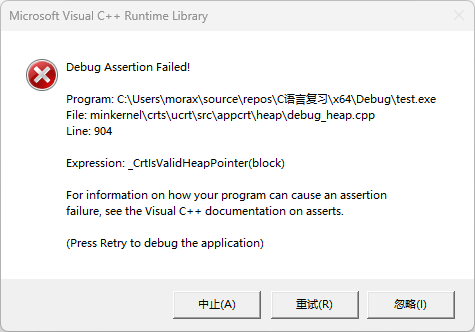
返回局部变量地址
#include <stdio.h>
#include <stdlib.h>
char *get_str() {
char str[] = "abcdedsgads";//栈区,
printf("[get_str]str = %s\n", str);
return str;
}
int main(void) {
char *p = NULL;
p = get_str();
printf("str=[%s]\n", p);
return 0;
}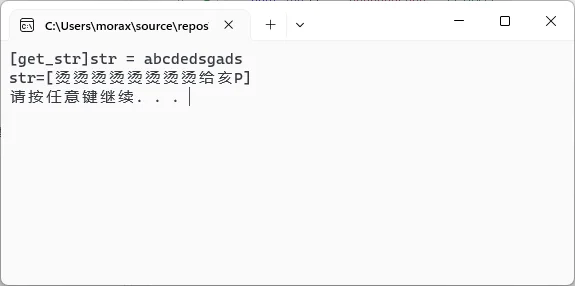
同一块内存释放多次(不可以释放野指针)
#include <stdio.h>
#include <stdlib.h>
#include <string.h>
void test() {
char *p = NULL;
p = (char *) malloc(50);
strcpy(p, "abcdef");
if (p != NULL) {
//free()函数的功能只是告诉系统 p 指向的内存可以回收了
// 就是说,p 指向的内存使用权交还给系统
//但是,p的值还是原来的值(野指针),p还是指向原来的内存
free(p);
}
if (p != NULL) {
free(p);
}
}
int main(void) {
test();
return 0;
}